1.15: Mammals I
- Page ID
- 55391
\( \newcommand{\vecs}[1]{\overset { \scriptstyle \rightharpoonup} {\mathbf{#1}} } \)
\( \newcommand{\vecd}[1]{\overset{-\!-\!\rightharpoonup}{\vphantom{a}\smash {#1}}} \)
\( \newcommand{\dsum}{\displaystyle\sum\limits} \)
\( \newcommand{\dint}{\displaystyle\int\limits} \)
\( \newcommand{\dlim}{\displaystyle\lim\limits} \)
\( \newcommand{\id}{\mathrm{id}}\) \( \newcommand{\Span}{\mathrm{span}}\)
( \newcommand{\kernel}{\mathrm{null}\,}\) \( \newcommand{\range}{\mathrm{range}\,}\)
\( \newcommand{\RealPart}{\mathrm{Re}}\) \( \newcommand{\ImaginaryPart}{\mathrm{Im}}\)
\( \newcommand{\Argument}{\mathrm{Arg}}\) \( \newcommand{\norm}[1]{\| #1 \|}\)
\( \newcommand{\inner}[2]{\langle #1, #2 \rangle}\)
\( \newcommand{\Span}{\mathrm{span}}\)
\( \newcommand{\id}{\mathrm{id}}\)
\( \newcommand{\Span}{\mathrm{span}}\)
\( \newcommand{\kernel}{\mathrm{null}\,}\)
\( \newcommand{\range}{\mathrm{range}\,}\)
\( \newcommand{\RealPart}{\mathrm{Re}}\)
\( \newcommand{\ImaginaryPart}{\mathrm{Im}}\)
\( \newcommand{\Argument}{\mathrm{Arg}}\)
\( \newcommand{\norm}[1]{\| #1 \|}\)
\( \newcommand{\inner}[2]{\langle #1, #2 \rangle}\)
\( \newcommand{\Span}{\mathrm{span}}\) \( \newcommand{\AA}{\unicode[.8,0]{x212B}}\)
\( \newcommand{\vectorA}[1]{\vec{#1}} % arrow\)
\( \newcommand{\vectorAt}[1]{\vec{\text{#1}}} % arrow\)
\( \newcommand{\vectorB}[1]{\overset { \scriptstyle \rightharpoonup} {\mathbf{#1}} } \)
\( \newcommand{\vectorC}[1]{\textbf{#1}} \)
\( \newcommand{\vectorD}[1]{\overrightarrow{#1}} \)
\( \newcommand{\vectorDt}[1]{\overrightarrow{\text{#1}}} \)
\( \newcommand{\vectE}[1]{\overset{-\!-\!\rightharpoonup}{\vphantom{a}\smash{\mathbf {#1}}}} \)
\( \newcommand{\vecs}[1]{\overset { \scriptstyle \rightharpoonup} {\mathbf{#1}} } \)
\( \newcommand{\vecd}[1]{\overset{-\!-\!\rightharpoonup}{\vphantom{a}\smash {#1}}} \)
\(\newcommand{\avec}{\mathbf a}\) \(\newcommand{\bvec}{\mathbf b}\) \(\newcommand{\cvec}{\mathbf c}\) \(\newcommand{\dvec}{\mathbf d}\) \(\newcommand{\dtil}{\widetilde{\mathbf d}}\) \(\newcommand{\evec}{\mathbf e}\) \(\newcommand{\fvec}{\mathbf f}\) \(\newcommand{\nvec}{\mathbf n}\) \(\newcommand{\pvec}{\mathbf p}\) \(\newcommand{\qvec}{\mathbf q}\) \(\newcommand{\svec}{\mathbf s}\) \(\newcommand{\tvec}{\mathbf t}\) \(\newcommand{\uvec}{\mathbf u}\) \(\newcommand{\vvec}{\mathbf v}\) \(\newcommand{\wvec}{\mathbf w}\) \(\newcommand{\xvec}{\mathbf x}\) \(\newcommand{\yvec}{\mathbf y}\) \(\newcommand{\zvec}{\mathbf z}\) \(\newcommand{\rvec}{\mathbf r}\) \(\newcommand{\mvec}{\mathbf m}\) \(\newcommand{\zerovec}{\mathbf 0}\) \(\newcommand{\onevec}{\mathbf 1}\) \(\newcommand{\real}{\mathbb R}\) \(\newcommand{\twovec}[2]{\left[\begin{array}{r}#1 \\ #2 \end{array}\right]}\) \(\newcommand{\ctwovec}[2]{\left[\begin{array}{c}#1 \\ #2 \end{array}\right]}\) \(\newcommand{\threevec}[3]{\left[\begin{array}{r}#1 \\ #2 \\ #3 \end{array}\right]}\) \(\newcommand{\cthreevec}[3]{\left[\begin{array}{c}#1 \\ #2 \\ #3 \end{array}\right]}\) \(\newcommand{\fourvec}[4]{\left[\begin{array}{r}#1 \\ #2 \\ #3 \\ #4 \end{array}\right]}\) \(\newcommand{\cfourvec}[4]{\left[\begin{array}{c}#1 \\ #2 \\ #3 \\ #4 \end{array}\right]}\) \(\newcommand{\fivevec}[5]{\left[\begin{array}{r}#1 \\ #2 \\ #3 \\ #4 \\ #5 \\ \end{array}\right]}\) \(\newcommand{\cfivevec}[5]{\left[\begin{array}{c}#1 \\ #2 \\ #3 \\ #4 \\ #5 \\ \end{array}\right]}\) \(\newcommand{\mattwo}[4]{\left[\begin{array}{rr}#1 \amp #2 \\ #3 \amp #4 \\ \end{array}\right]}\) \(\newcommand{\laspan}[1]{\text{Span}\{#1\}}\) \(\newcommand{\bcal}{\cal B}\) \(\newcommand{\ccal}{\cal C}\) \(\newcommand{\scal}{\cal S}\) \(\newcommand{\wcal}{\cal W}\) \(\newcommand{\ecal}{\cal E}\) \(\newcommand{\coords}[2]{\left\{#1\right\}_{#2}}\) \(\newcommand{\gray}[1]{\color{gray}{#1}}\) \(\newcommand{\lgray}[1]{\color{lightgray}{#1}}\) \(\newcommand{\rank}{\operatorname{rank}}\) \(\newcommand{\row}{\text{Row}}\) \(\newcommand{\col}{\text{Col}}\) \(\renewcommand{\row}{\text{Row}}\) \(\newcommand{\nul}{\text{Nul}}\) \(\newcommand{\var}{\text{Var}}\) \(\newcommand{\corr}{\text{corr}}\) \(\newcommand{\len}[1]{\left|#1\right|}\) \(\newcommand{\bbar}{\overline{\bvec}}\) \(\newcommand{\bhat}{\widehat{\bvec}}\) \(\newcommand{\bperp}{\bvec^\perp}\) \(\newcommand{\xhat}{\widehat{\xvec}}\) \(\newcommand{\vhat}{\widehat{\vvec}}\) \(\newcommand{\uhat}{\widehat{\uvec}}\) \(\newcommand{\what}{\widehat{\wvec}}\) \(\newcommand{\Sighat}{\widehat{\Sigma}}\) \(\newcommand{\lt}{<}\) \(\newcommand{\gt}{>}\) \(\newcommand{\amp}{&}\) \(\definecolor{fillinmathshade}{gray}{0.9}\)Learning Objectives
- Describe unique anatomy and physiology of mice, rats, hamsters, gerbils, guinea pigs, and chinchillas
- Describe sexing of the above species
- Describing housing considerations for the above species
- Describe control of diseases and parasites for the above species
- Describe normal behaviors for the above species
- Describe nutrition for the above species
- Describe dentistry for rats, hamsters, gerbils, guinea pigs, and chinchillas
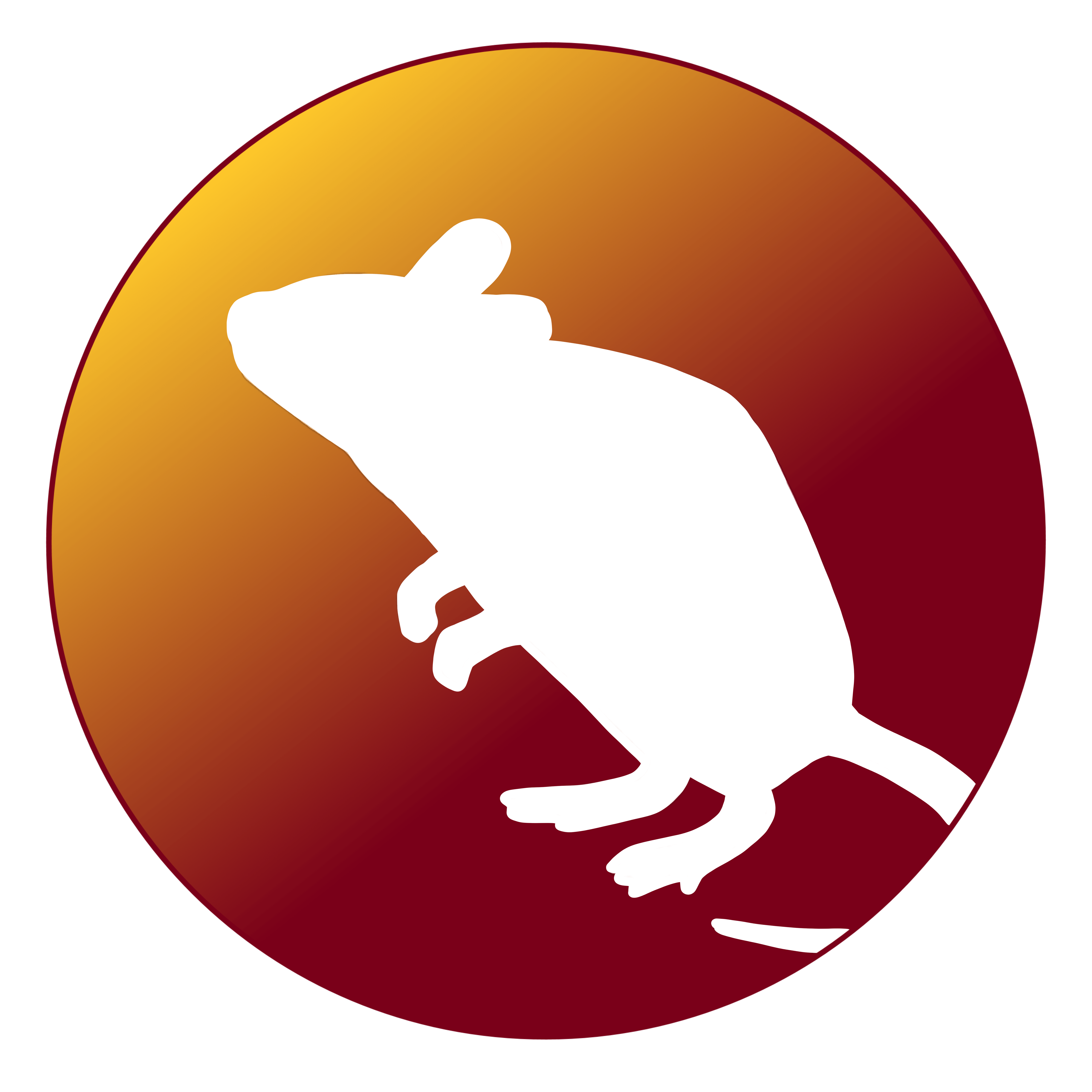 Mice
Mice
Unique Anatomy and Biology
Biology of Mice
| LIFE SPAN | 2 years |
| TEMPERATURE | 98-101°F (36.5-38.0°C) |
| PULSE | 325-780 beats/minute |
| RESPIRATION | 40-80 breaths/minute |
| REPRODUCTIVE MATURITY | ♀ puberty 28-40 days, ♂ breeding initiation 50 days |
House mice are 2.5-3” (6.5-7.5 cm) long and weigh 0.5-1 oz (20-40 gm). Mice sold in the pet trade are descended from house mice and have a slightly different appearance. Mice have a small head with a long, narrow snout. House mice are usually gray-brown with a light to white underbelly but pet mice can come in a variety of colors. They have large, round, black or red eyes, and large ears. Anatomy includes only 2 open-rooted (continuously growing) incisors with nerves only at the base, ability to draw the cheek folds into the diastema (space between the incisors and molars), and large masseter muscles that attach rostrally, giving them increased ability to gnaw. All rodents are obligate nose breathers.
Appearance of Mice
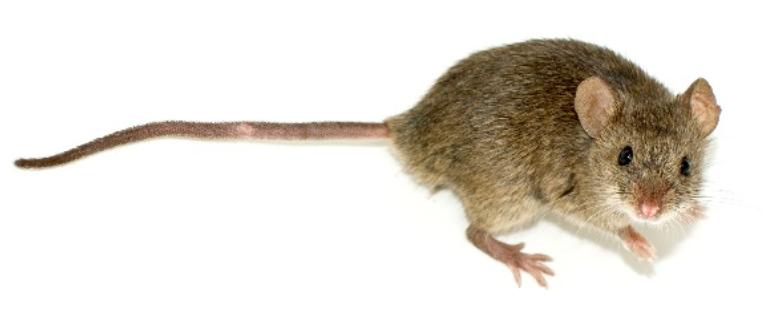
|
Gender identification is through assessment of the anogenital distance, which is about twice as long in males as in females.
Gender Identification in Mice
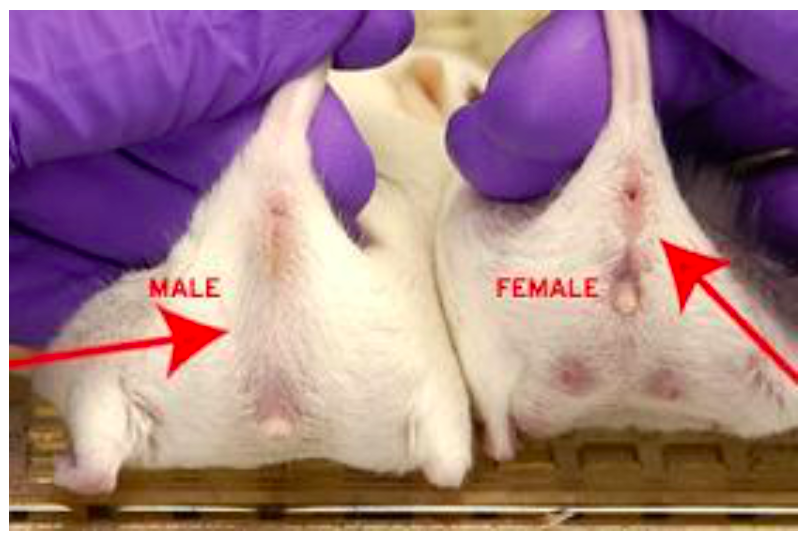
|
Specifics of anatomy and other information about mice and rats can be found in the Manual of Exotic Pet Practice, pp 326-344.
Housing
Suitable homes can be purchased or made. The bottom should be plastic or another material that will withstand gnawing and it should have closely spaced bars to prevent escape. Aquariums are excellent choices for mice. Mouse cages must have a lid or cover because mice are excellent climbers. The enclosure must be large enough for the mouse or mice, food and water, and enrichment, such as an exercise wheel. Mice also appreciate somewhere in the cage where they can hide. Appropriate bedding materials include wood shavings, ground corn cobs, pelleted sawdust, newspaper, and straw. Cedar and pine wood shavings sold as small animal bedding contain phenol that can be toxic or cause airway damage. Bedding should be replaced and the cage thoroughly cleaned 2-3 times per week. Mice don’t drink a lot of water, but water should be available at all times. Open containers become contaminated with urine and feces quickly. Vacuum-type bottles with sipper tubes are ideal. Temperature, humidity, and lighting can be as that for the rest of the house.
Vaccinations and Disease Control
There are no vaccines recommended for control of infectious disease in mice.
Parasite Control
Internal parasites of mice include protozoa, pinworms, and tapeworms. These can be identified on fecal flotation or by direct inspection. Treatment varies with specific worm identified. External parasites are uncommon in captive-bred mice. Fur mites and lice can be seen, and are associated with pruritus to the point of self-mutilation and hair loss. Diagnosis is by direct inspection. Treatment is dependent on parasite identified; ivermectin is a common therapy.
Behavior
Mice are primarily nocturnal in habit but pet mice, feeling safe around humans, may come out during the day. Mice are outgoing, social creatures. They prefer the company of other mice. Male mice housed together may be territorial, and fight. Another abnormal behavior of mice housed together is barbering, the chewing away of the whiskers and the hair on the face of a submissive mouse, often by a dominant female mouse. Mice are fastidious groomers and early signs of disease often include a scruffy hair coat.
Dentistry
While many species of rodent require dentistry to correct or prevent overgrowth of their continually growing incisors, this is not a common problem in most mice. If malocclusion is present, the overgrown incisors easily can be identified on physical examination.
Biosecurity
Good general hygiene should offset any concerns about passage of disease from pet mice to humans; handwashing after handling rodents is essential. Many pet store mice do test positive for lymphocytic choriomeningitis virus, which can pose a risk to the unborn baby if a pregnant woman contracts the disease.
Nutrition
A commercial mouse feed that is complete and balanced with at least 14% protein is most appropriate. Treats specifically prepared for mice can be purchased. Other foods that can be offered but that should never make up any significant percentage of the animal’s total food intake include leafy greens, broccoli, apples, celery, carrots, and dry bread. Mice should never be fed chocolate, peanuts, alcohol, onions, garlic, or citrus fruits.
 Rats
Rats
Unique Anatomy and Biology
Biology of Rats
| LIFE SPAN | 2-3 years |
| TEMPERATURE | 99-101°F (37-38°C) |
| PULSE | 250-450 beats/minute |
| RESPIRATION | 70-115 breaths/minute |
| REPRODUCTIVE MATURITY | ♀ puberty 65-110 days, ♂ breeding initiation 65-110 days |
Of the 78 species of rats, only two have been domesticated as pets and for use in research, the black rat, also called the roof rat, and the brown or Norway rat. The body and head of the black rat is 5-7” (13-18 cm) long with a tail longer than its body. They weigh 4-12 oz (115-340 gm). The ears of the black rat are large and they have black or dark gray fur with a brown or gray-white underside. The brown rat is larger, with a body and head 7-10” (18-25 cm) long and a tail that is shorter than its head and body. They weigh 7-17 oz (200-400 gm). The ears of the brown rat are smaller in relationship to its head than those of the black rat. Their fur is usually dark brown to gray-brown with a lighter brown or gray underside. Pet rats descended from these two species come in a variety of colors and coat patterns.
Appearance of Rats
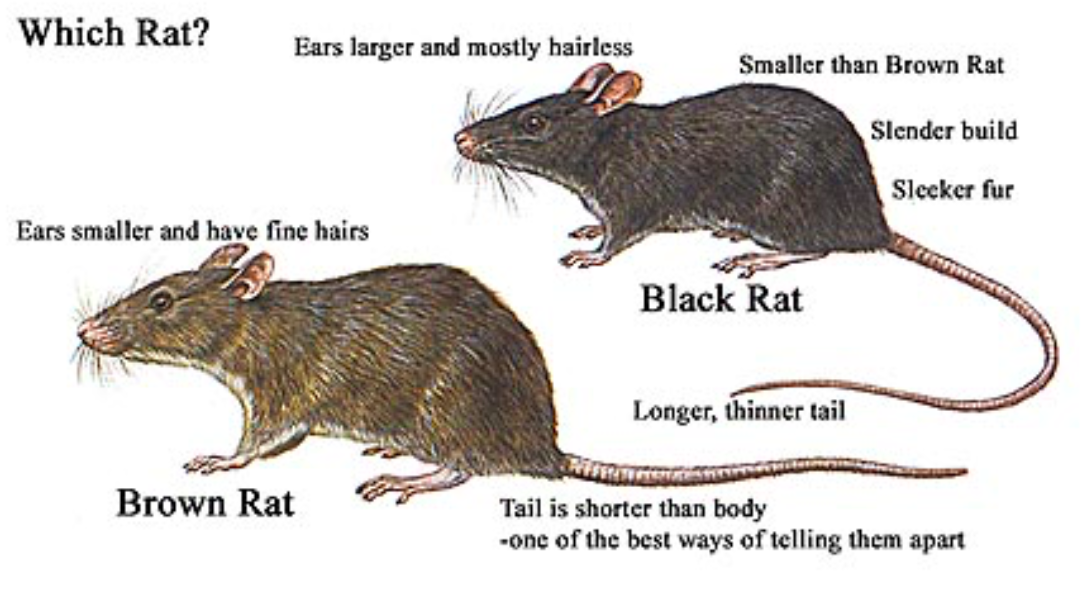
Other unique anatomy is as for the mouse.
Gender identification is through assessment of anogenital distance, which is about 1.5-2 times longer in males than in females, or by direct observation of descended testes or extrusion of the penis. If the testes are not visible between the anus and genital papilla, gentle pressure on either side of the genital papilla in a male will result in extrusion of a small, red penis. Nipples are more prominent in females.
Gender Identification in Rats
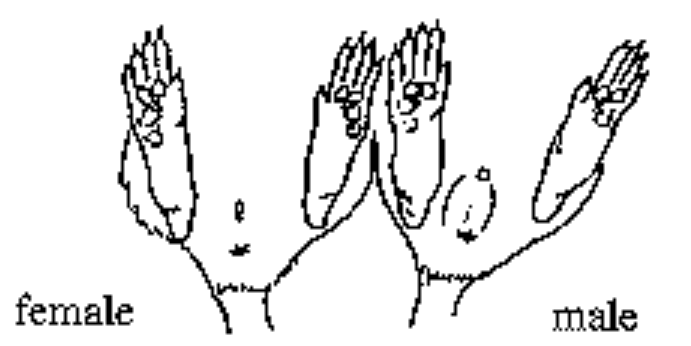
|
Specifics of anatomy and other information about mice and rats can be found in the Manual of Exotic Pet Practice, pp 326-344.
Housing
Wire mesh cages with solid bottoms or pull-out trays are recommended for rats. Cages can be constructed from wood and wire mesh, but materials must be thick enough to withstand gnawing. Glass aquariums work well for rats because they’re easy to clean and are escape-proof with a lid. Larger cages are recommended because rats are active and benefit from environmental enrichment like ladders, ropes, and exercise wheels. Like mice, rats need a place to hide in their cage. Appropriate bedding materials include wood shavings, ground corn cobs, pelleted sawdust, newspaper and straw. Cedar and pine wood shavings sold as small animal bedding contain phenol that can be toxic or cause airway damage. Bedding should be replaced and the cage thoroughly cleaned 2-3 times per week. Rats need access to water at all times. A bottle with a sipper tube suspended from the cage is the best option. Temperature, humidity, and lighting should be as for the rest of the household.

Vaccinations and Disease Control
There are no vaccines recommended for control of infectious disease in rats.
Parasite Control
Internal parasites of rats include protozoa, pinworms, and tapeworms. These can be identified on fecal flotation or by direct inspection. Treatment varies with specific worm identified. External parasites are even more uncommon in captive-bred rats than in mice.
Behavior
Rats are primarily nocturnal, however, those kept as domestic pets are active all day and can be handled by owners. Rats are agile climbers, particularly the black rat. They use their tails for balance. They can jump up to two feet and are excellent swimmers, able to stay submerged for up to 3 minutes. They’re curious and will climb a cage or stand on their hind legs to see their environment. Rats are intelligent and will learn their owner’s voice and come when food or interaction is offered. Social and outgoing, rats do best when kept with other rats. Animals raised together will usually get along but, as with any animals, introducing a new rat may lead to fighting and rat fights can result in injury or death. Rat fighting should not be confused with wrestling behavior, which is affiliative play. When upset, rats can be imposing. They stiffen their bodies, arch their backs, wag their tails, and begin shaking with their hair standing on end to make them appear larger.
Dentistry
Because they have continuously growing incisors, if the teeth are not worn down by normal activity or if malocclusion is present, the incisors can overgrow, causing significant oral disease. This is easily identified on physical examination. Because the teeth have no nerve except at the base, they can be trimmed as needed by a veterinarian using a dental disc. Repeat trimming may be required if the underlying cause of the malocclusion cannot be resolved.
Biosecurity
Good general hygiene should offset any concerns about passage of disease from pet rats to humans.
Nutrition
Commercial pellet rations containing 20-27% protein formulated for small mammals are ideal because they are nutritionally complete and balanced. Treats specifically prepared for rats can be purchased. Other foods that can be offered but that should never make up any significant percentage of the animal’s total food intake include apples, bananas, strawberries, melon, broccoli, carrots, squash, lean cooked meats, whole wheat bread, cooked beans, and yogurt. Rats should never be fed chocolate, alcohol, cabbage, high-fat or high-sugar human foods, or citrus fruits.

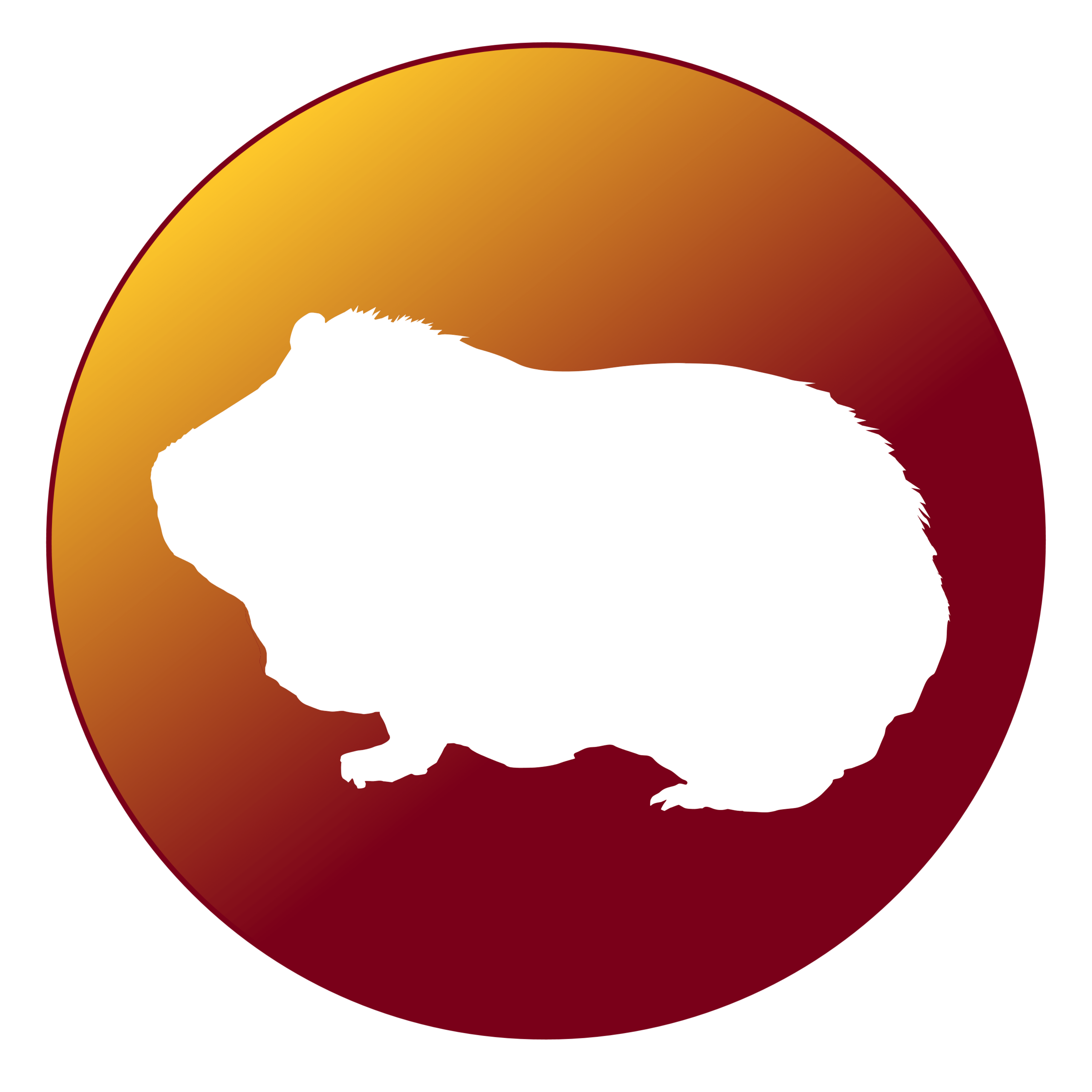 Hamsters
Hamsters
It is illegal in Hawaii to own a hamster. In California, it is illegal to own hamsters unless they are of the domesticated species (Syrian or dwarf hamster) and the laws are unclear regarding whether or not even those may be illegal in some municipalities.
Unique Anatomy and Biology
Biology of Hamsters
| LIFE SPAN | 18-24 months |
| TEMPERATURE | 99-101°F (37-38°C) |
| PULSE | 310-471 beats/minute |
| RESPIRATION | 38-110 breaths/minute |
| REPRODUCTIVE MATURITY | ♀ puberty 42-70 days, ♂ breeding initiation 70-98 days |
The most common hamster in the United States is the golden or Syrian hamster. They are 5-7” (13-18 cm) in length, with an average body weight of 4 oz (120 gm). Like mice, hamsters have 2 open-rooted (continuously growing) incisors with nerves only at the base, ability to draw the cheek folds into the diastema, and large masseter muscles that attach rostrally, giving them increased ability to gnaw. They have large cheek pouches that can be used for storage of food and bedding. They are obligate nose breathers. All hamsters have sebaceous glands on their flank, brown patches covered with fur that may appear wet and matted, especially in sexually aroused males.
Appearance of Hamsters
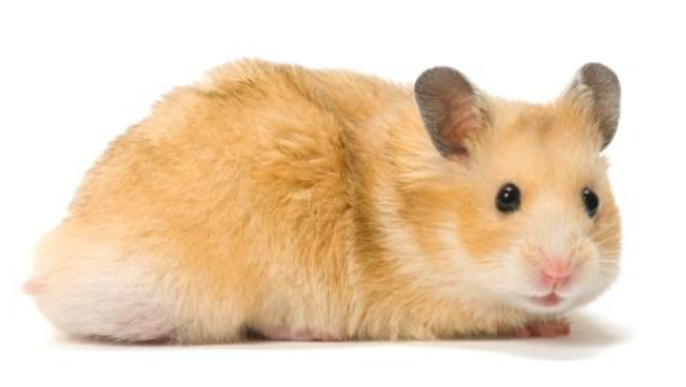
|
Gender identification is through increased anogenital distance in males, the presence of testes in males between the anus and genital papilla, and prominence of nipples in females.
Gender Identification in Hamsters
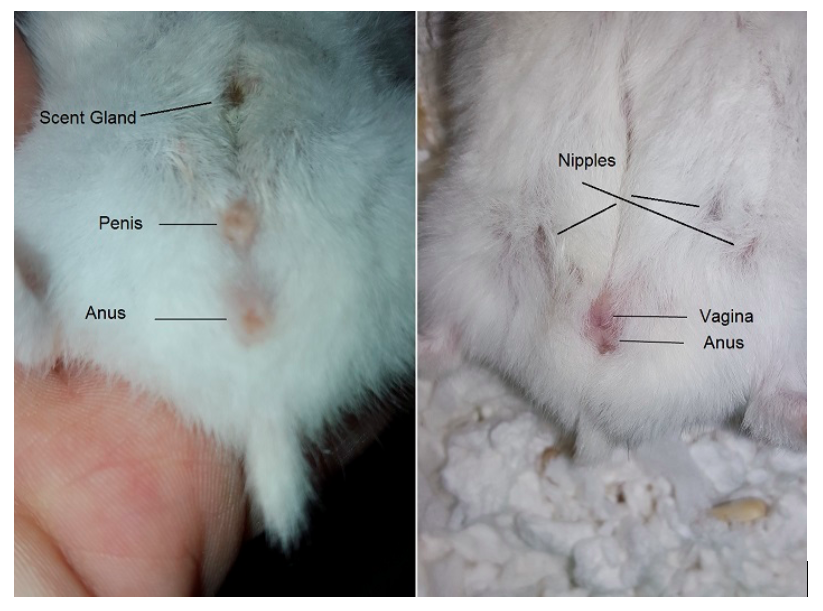
Specifics of anatomy and other information about hamsters and gerbils can be found in the Manual of Exotic Pet Practice, pp 406-432.
Housing
Hamsters are best housed alone. Hamster cages should be large enough to allow room for an exercise wheel and a place for the hamster to hide also should be provided. Simple wire cages are available in pet stores. Aquariums and custom-made hamster homes are also available; all cages should be gnaw-proof, as for other rodents. Clean fresh bedding can be paper confetti, paper strips, wood chips or shavings, ground corn cobs, hay, or straw. Corn cobs and wood shavings usually work the best because of their absorbency. Cedar should be avoided because the fumes may cause respiratory problems. The cage should be cleaned 2-3 times per week. Water bottles should be hung on the outside of the cage with a drinking tube extending into the cage through the side bars. This prevents the hamster from gnawing on the bottom of the water bottle and frees up space within the cage. If the water bottle is stored in the cage, it should be kept in a protective wire hanger. Hamsters prefer moderate temperatures around 70°F. If the temperature goes above 80°F, they go into a deep, sleep-like state known as estivation. This is how hamsters originally survived the hot, dry desert environment. If the temperature goes below 50°F, hamsters will hibernate. Lighting should be as for the rest of the household; a 12 hr light:dark cycle is preferred for most hamsters.
Vaccinations and Disease Control
There are no vaccines recommended for control of infectious disease in hamsters.
Parasite Control
Internal parasites of hamsters include protozoa, pinworms, and tapeworms. These can be identified on fecal flotation or by direct inspection. Treatment varies with specific worm identified. The most common external parasite of hamsters is the demodectic mange mite. Clinically normal hamsters can carry a small number of mites. Clinical disease may be seen as a secondary problem in older hamsters with other disease conditions. The signs of demodectic mange are a non-pruritic alopecia and scaling and crusting over the back and rump. Demodectic mange can be treated with ivermectin.
Behavior
Hamsters are nocturnal. Hamsters tend to be territorial and protective of food and it’s not uncommon to see hoarding behavior in hamsters. They will hide food at one end of their habitat and reserve the other end for urinating and defecating. Hamsters are solitary creatures. Young can usually be kept together until they are about 5 weeks old; then they will begin to fight and need to be separated. Cannibalism may result if litters are left together for longer periods of time. Females only tolerate the male for breeding.
Dentistry
Because they have continuously growing incisors, if the teeth are not worn down by normal activity or if malocclusion is present, the incisors can overgrow, causing significant oral disease. This is easily identified on physical examination. Because the teeth have no nerve except at the base, they can be trimmed as needed by a veterinarian using a dental disc.
Biosecurity
Good general hygiene should offset any concerns about passage of disease from pet hamsters to humans.
Nutrition
The best way to feed a hamster is to purchase commercially prepared pellets that contain a minimum of 16% protein and 4-5% fat and are complete and balanced for hamsters. Other foods that can be offered but that should never make up any significant percentage of the animal’s total food intake include most fruits and vegetables, cooked brown rice, and toast. Hamsters should never be fed chocolate, alcohol, onions, garlic, high-fat or high-sugar human foods, almonds, or citrus fruits. Uneaten soft-type foods must be removed before they spoil. Soft foods may get lodged in the cheek pouches of a hamster and become spoiled causing infection and illness.
 Gerbils
Gerbils
Because they can damage crops and out-compete indigenous wildlife, it is illegal to have gerbils as pets in the state of California.
Unique Anatomy and Biology
Biology of Gerbils
| LIFE SPAN | 24-39 months |
| TEMPERATURE | 100.4-102.2°F (38-39°C) |
| PULSE | 260-600 beats/minute |
| RESPIRATION | 85-160 breaths/minute |
| REPRODUCTIVE MATURITY | ♀ puberty 65-85 days, ♂ breeding initiation 70-85 days |
The best known species is the Mongolian gerbil. On average, the Mongolian gerbil is 6-8” (15-20 cm) from tip of the nose to tip of the tail. Their bodies are 3-4” (7.5-10 cm) long and they weigh 3-4 oz (85-114 gm). Gerbils do not sweat and produce extremely concentrated urine. Gerbils have a hairless patch on their midventral abdomen that is a scent gland.
Appearance of Gerbils
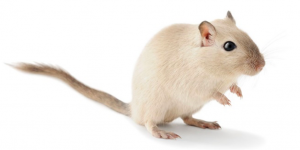
|
Gender identification is by anogenital distance, which is longer in the male; by dark pigmentation of the scrotum; and by increased size of the scent gland in males and increased prominence of nipples in females.
Gender Identification in Gerbils
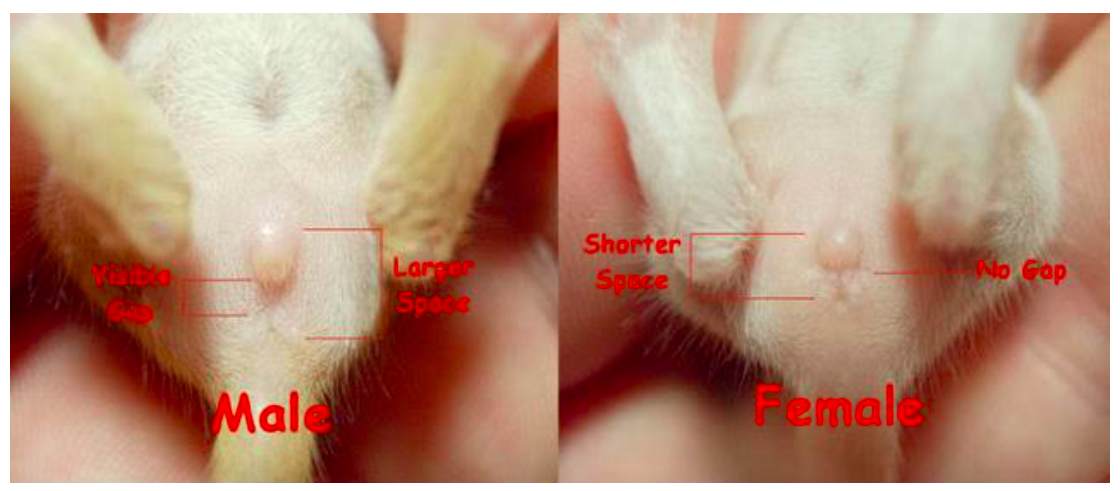
Specifics of anatomy and other information about hamsters and gerbils can be found in the Manual of Exotic Pet Practice, pp 406-432.
Housing
Most hamster housing is also appropriate for gerbils. Because of their highly concentrated urine, the ideal habitat for gerbils is an aquarium. It is important that the enclosure have a lid to prevent the gerbil from jumping out. Gerbils require enrichment like hamsters but caution should be used with exercise wheels, which may be associated with degloving injuries of the tail or limb fractures. Running wheels should be solid, not mesh. Gerbils also may use a sandy area in a cage for environmental enrichment. Gerbils are social animals and can be housed in pairs or family groups. If necessary, gerbils can get most of their daily water requirement from their food. Although they can survive without, free access to water is recommended. Temperature and lighting are as for hamsters. Relative humidity is best kept at less than 50%.
Vaccinations and Disease Control
There are no vaccines recommended for control of infectious disease in gerbils.
Parasite Control
There are virtually no clinically significant internal parasites routinely diagnosed in gerbils. Gerbils can suffer from demodectic mange as described for hamsters.
Behavior
Mongolian gerbils are diurnal, active during the day. Gerbils are very quiet animals. The young can be heard making squeaking noises, but the sounds diminish as they age. Gerbils communicate by drumming or pounding with their rear feet. This sound is also used as an alarm and by the male during mating. Gerbils commonly leave their scent behind by rubbing their abdomen along an object or area.
Dentistry
Because they have continuously growing incisors, if the teeth are not worn down by normal activity or if malocclusion is present, the incisors can overgrow, causing significant oral disease. This is easily identified on physical examination. Because the teeth have no nerve except at the base, they can be trimmed as needed by a veterinarian using a dental disc.
Biosecurity
Good general hygiene should offset any concerns about passage of disease from pet gerbils to humans.
Nutrition
The best way to feed a gerbil is to purchase commercially prepared pellets that contain a minimum of at least 20% protein and 4-5% fat and are complete and balanced for gerbils. Other foods that can be offered but that should never make up any significant percentage of the animal’s total food intake include apples, pears, bananas, carrots, celery, peas, cucumbers, cooked potato, and plain popcorn. Gerbils should never be fed chocolate, alcohol, spinach, lettuce, or citrus fruits.

 Guinea Pigs
Guinea Pigs
Unique Anatomy and Biology
Biology of Guinea Pigs
| LIFE SPAN | 5-7 years |
| TEMPERATURE | 99-103.1°F (37.2-39.5°C) |
| PULSE | 240-350 beats/minute |
| RESPIRATION | 40-150 breaths/minute |
| REPRODUCTIVE MATURITY | ♀ puberty 6 weeks, ♂ breeding initiation 10 weeks |
Adult guinea pigs reach a length of 8-10” (20-25 cm) and weigh 1-2 lb (450-900 gm). Males are larger and have larger, more rounded heads than females. The body of the guinea pig is short, stocky in build, with short legs. The nose of the guinea pig is short, blunt, and rounded. They have a small mouth with a split upper lip. There are long whiskers on the sides of the upper lip that function in the same way that cat whiskers do, allowing the animal to travel in dim light. The ears are short with little fur. Guinea pigs have very sensitive hearing and can detect frequencies beyond the range of the human ear. All of their teeth are open-rooted including the molars. Like all other rodents, they are obligate nose breathers.
Appearance of Guinea Pigs
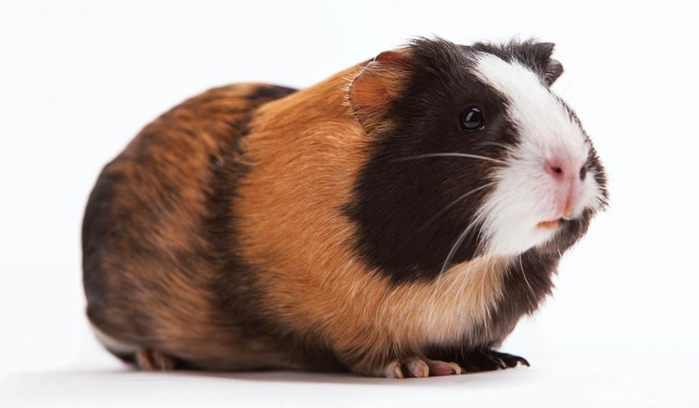
|
Gender identification done in several ways. Methods include determination of anogenital distance as in other species, examination of the genitalia itself (urethral opening a single point and area raised in males, urethral opening a slit and area flush with the surrounding skin in females), and identification of large testes to either side of the anus.
Gender Identification in Guinea Pigs
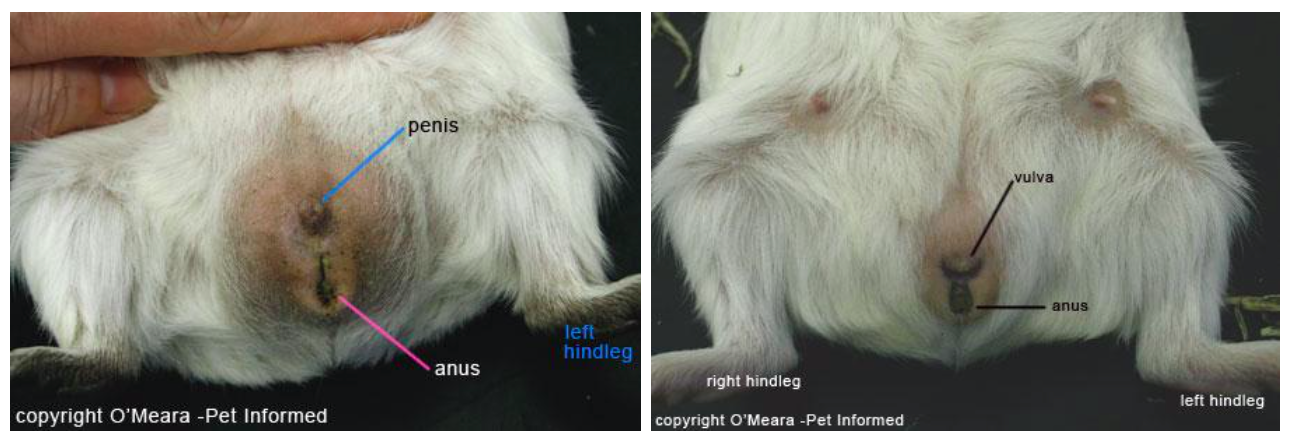

|
Specifics of anatomy and other information about guinea pigs can be found in the Manual of Exotic Pet Practice, pp 456-473.
Housing
A typical cage has a solid bottom that is 3-4” deep with vertical bars made of wire. The plastic bottom should be removable for cleaning. Deeper trays keep animals from scattering bedding or shavings out of the cage. Cages do not need covers or tops because guinea pigs don’t usually climb. Appropriate bedding includes recycled newspaper products, shredded paper, and aspen shavings. Cedar and pine shavings should not be used as they may be a respiratory irritant. Cages should be cleaned 1-2 times weekly and sanitized at least once every 2 weeks. Guinea pigs will defecate into their feed and water. For this reason, an elevated feeder and vacuum-type water bottle are recommended. In the summer, guinea pigs can be kept outside once temperatures are above 50°F. Small houses, like dog houses, can be constructed to keep animals safe and protected from the elements. Outdoor housing should be portable so it can be moved when grass becomes trampled or eaten. Guinea pigs should never be housed in areas with temperature greater than 80°F or in areas of high humidity as they are susceptible to hyperthermia.
Vaccinations and Disease Control
There are no vaccines recommended for control of infectious disease in guinea pigs. However, if guinea pigs are kept in households with dogs or cats, vaccination against Bordetella bronchiseptica is recommended as they are susceptible and are exquisitely sensitive to contracting it.
Some husbandry that can help prevent disease in guinea pigs includes brushing and nail trimming. Guinea pigs should be brushed regularly. A guinea pig with rosettes and long hair will need to have the hair combed out in addition to brushing. Long-haired animals may also need their hair clipped around the rear to prevent matting and soiling. Guinea pigs can be bathed with a mild shampoo, for example baby shampoo. Guinea pig toenails grow constantly and need to be trimmed with regular pet toenail clippers.
Parasite Control
Internal parasites, including roundworms and coccidia, are found uncommonly in guinea pigs. External parasites, including mites, lice, and fleas, may be more commonly seen and are easily identified by inspection and treated as in other species.
Behavior
Guinea pigs are neither completely diurnal nor completely nocturnal but instead show periods of activity and sleep throughout the day. Guinea pigs may be housed in groups but two males are unlikely to live peacefully in an enclosure. In general, guinea pigs are social and respond to the activity around them with a variety of vocalizations.
Dentistry
Because they have continuously growing incisors and molars, if the teeth are not worn down by normal activity or if malocclusion is present, the teeth can overgrow, causing significant oral disease. The open-rooted molars also are predisposed to dental caries and subsequent infection. This is easily identified on physical examination but complete evaluation may require sedation and treatment requires general anesthesia. Dental radiographs may be required for complete evaluation and treatment may include trimming as in other rodents or floating to remove sharp points, as is done in horses.
Biosecurity
Good general hygiene should offset any concerns about passage of disease from pet guinea pigs to humans.
Sterilization
Elective ovariohysterectomy or ovariectomy may be performed in female guinea pigs (sows) for reproduction control. The surgery is performed as in dogs and cats, with specific care taken to avoid the large cecum on entering the abdomen, and not to tear the ovarian vessels by placing undue tension while attempting to exteriorize the ovaries. Elective orchiectomy (castration) is performed in male guinea pigs (boars) either for reproduction control or to minimize reproductive behaviors. The surgery is performed as in cats and it is required that the inguinal canal be closed on each side to prevent herniation of abdominal contents. Skin incisions are closed with suture or tissue glue.
Nutrition
High-quality hay should be available at all times. Alfalfa hay is appropriate for young guinea pigs and for pregnant sows. Timothy hay and orchard grass are appropriate for grown animals. A commercial pelleted diet formulated specifically for guinea pigs should be provided as well but should not be the primary diet as that commonly causes obesity. Fresh vegetables should make up the rest of the diet. Fruits and grains also can be provided but should never be more than 10% of the diet. Good supplementary foods for guinea pigs include bell peppers, parsley, kale, broccoli, Brussels sprouts, romaine lettuce, carrots, dandelion greens, apples, cantaloupe, and oranges. Guinea pigs cannot manufacture their own vitamin C. Vitamin C in pelleted food or offered in water breaks down quickly and provision of foods high in vitamin C or vitamin C supplements is recommended. Foods you should never give to a guinea pig include beans, rhubarb, dill, flowers, and the pits, cores or seeds of fruits.

 Chinchillas
Chinchillas
Unique Anatomy and Biology
Biology of Chinchillas
| LIFE SPAN | 8-10 years, with some pets recorded to live up to 20 years |
| TEMPERATURE | 100.5-102.2°F (38-39°C) |
| PULSE | 100-200 beats per minute |
| RESPIRATION | 40-80 breaths/minute |
| REPRODUCTIVE MATURITY | ♀ puberty 7-9 months, ♂ breeding initiation 7-9 months |
Chinchillas resemble small rabbits with short ears and a short, bushy tail. Chinchillas range from 9-15” (23-38 cm) long with a tail of 3-10” (7.5-25 cm), and weigh from 1 to 2 lb (400-700 gm). Their thick, shiny fur is about 1” long; the most common color of chinchillas is blue-grey. The softness of the fur is due to the fewer number of guard hairs as compared with those of fur-bearing animals. Chinchillas usually shed about every 3 months. New growth starts at the neck and progresses toward the rear of the animal. The head is broad with large ears and eyes. They have very long, stiff whiskers.
Appearance of Chinchillas
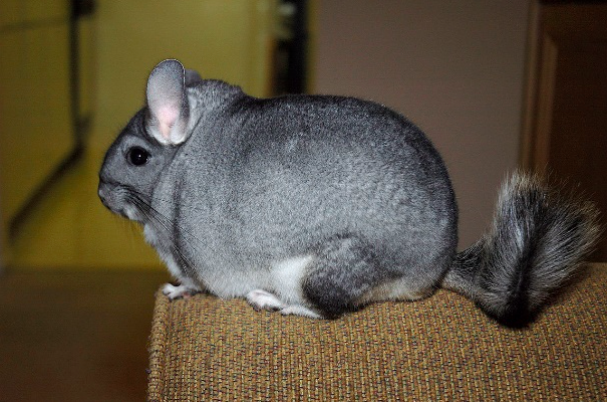
|
Gender identification is through anogenital distance, which is much longer in males than in females. The male below is shown on the left.
Gender Identification of Chinchillas ![]()

Specifics of anatomy and other information about chinchillas can be found in the Manual of Exotic Pet Practice, pp 474-492.
Housing
Chinchillas require a relatively large enclosure with specific areas for eating, sleeping, exercising, and urinating / defecating. An area for animals to hide should be included. Dust baths should be made available as described below in the behavior section. Enclosures may have more the one level with ladders to encourage exercise. Cages should be made of metal and wire; plastic and wood will be quickly chewed through. Wire mesh is not recommended for flooring. Wood shavings and ground corn cobs are ideal bedding. Hay and straw should not be used as they may become moldy or stain fur. The enclosure should be cleaned twice weekly. Clean water should be provided in glass sipper bottles. Temperature should be kept at less than 80°F and humidity at a comfortable level for humans, as chinchillas suffer heat prostration / hyperthermia if maintained in higher environmental temperatures, especially if humidity is high.
Vaccinations and Disease Control
There are no vaccines recommended for control of infectious disease in chinchillas.
Parasite Control
Endoparasites are uncommon in pet chinchillas. Chinchillas can carry Giardia sp. without signs of disease. Chinchillas can be infested with fleas and mites but this is uncommon in pets. Diagnosis is by direct inspection and treatment is as in other species.
Behavior
Chinchillas are nocturnal in the wild but can adapt to a diurnal lifestyle as pets.
Chinchillas need regular baths to remove excess moisture and oil. They do not bathe in water, but in finely ground powder. In the wild, chinchillas bathe in volcanic ash of the Andes Mountains. A similar powder is available for purchase from pet stores. Chinchillas can be bathed in a small pan with 2-3” inches of powder. The pan needs to be large enough for the animal to roll around in. The powder can be used several times.
Fur chewing is a common problem of chinchillas. The animal chews the fur on the flanks leaving patches of short hair. Poor nutrition, small cages, drafty conditions, boredom, and high humidity are thought to play a role in fur chewing. Providing enough space and environmental enrichment along with a balanced diet should resolve fur chewing.

Dentistry
Because they have continuously growing incisors and molars, if the teeth are not worn down by normal activity or if malocclusion is present, the teeth can overgrow, causing significant oral disease. The open-rooted molars also are predisposed to dental caries and subsequent infection. This is easily identified on physical examination but complete evaluation requires sedation and treatment requires general anesthesia. Dental radiographs may be required for complete evaluation and treatment may include trimming as in other rodents or floating to remove sharp points, as is done in horses. The open-rooted molars also can overgrow into the jaw, causing pain and inappetance. Radiographs are used to diagnose this progressive condition, which has a very poor prognosis.
Biosecurity
Good general hygiene should offset any concerns about passage of disease from pet chinchillas to humans.
Sterilization
Elective ovariohysterectomy or ovariectomy may be performed in female chinchillas for reproduction control. The surgery is performed as in dogs and cats, with specific care taken to avoid the large cecum on entering the abdomen, and not to tear the ovarian vessels by placing undue tension while attempting to exteriorize the ovaries. Elective orchiectomy (castration) is performed in male chinchillas either for reproduction control or to minimize reproductive behaviors. The surgery is performed as in cats and it is required that the inguinal canal be closed on each side to prevent herniation of abdominal contents. Skin incisions are closed with suture or tissue glue.
Nutrition
Various pelleted foods are available today for chinchillas. These pellets consist primarily of ground alfalfa hay, corn gluten, corn tailings, wheat germ, and bran, with 16-20% protein, 2-5% fat, and 15-35% fiber. Commercially prepared foods are nutritionally complete. Chinchillas can be sensitive to dietary changes and any changes should be made gradually. Chinchillas are “hind gut” fermenters, producing cecal pellets that are reingested (coprophagy). Chinchillas also can be offered high-quality timothy or orchard grass hay and dark leafy vegetables, such as romaine lettuce and collard or mustard greens. Very occasionally, chinchillas can be offered dried or fresh apple, banana, peach, or pear, prunes, and carrot. Chinchillas should be not offered high-fat or high-sugar human treats, chocolate, corn, or acidic fruits.


 Extra Resources
Extra Resources
- Common disorders of rats and mice: http://www.merckvetmanual.com/exotic-and-laboratory-animals/rodents/mice-and-rats-as-pets
- Common disorders of hamsters: http://www.merckvetmanual.com/exotic-and-laboratory-animals/rodents/hamsters
- Common disorders of gerbils: http://www.merckvetmanual.com/exotic-and-laboratory-animals/rodents/gerbils
- Common disorders of guinea pigs: http://www.merckvetmanual.com/exotic-and-laboratory-animals/rodents/guinea%20pigs
- Common disorders of chinchillas: http://www.merckvetmanual.com/exotic-and-laboratory-animals/rodents/chinchillas
- American Fancy Rat and Mouse Association: http://www.afrma.org/caresheet.htm
- California Hamster Association: http://www.chahamsters.org/newsletter.html
- American Gerbil Association: http://www.agsgerbils.org/
- American Cavy Breeders Association: http://www.acbaonline.com/
- Guinea Pigs Club: http://guineapigsclub.com/
- National Chinchilla Society: http://www.natchinsoc.co.uk/
- The Manual of Exotic Pet Practice: http://www.sciencedirect.com/science/book/9781416001195


